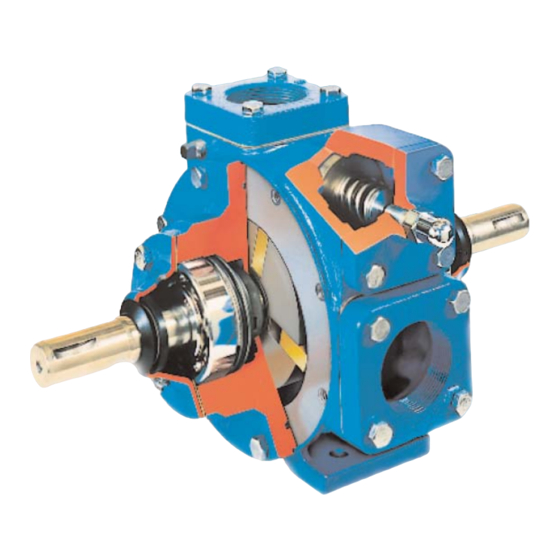Dover PSG Blackmer TXD1225A Інструкції з монтажу, експлуатації та технічного обслуговування - Сторінка 6
Переглянути онлайн або завантажити pdf Інструкції з монтажу, експлуатації та технічного обслуговування для Водяний насос Dover PSG Blackmer TXD1225A. Dover PSG Blackmer TXD1225A 12 сторінок.

FLUSHING THE PUMP
NOTICE:
If flushing fluid is to be left in the pump for an extended
time, it must be a lubricating, non-corrosive fluid. If a
corrosive, non-lubricating fluid is used, it must be
flushed from the pump immediately.
To flush the pump, use the following procedure:
1.
Allow the pump to evacuate as much fluid as possible.
2.
Run cleaning fluid through the pump intake. The
cleaning fluid should be compatible with the pump O-rings
and vane material. When handling "sticky" fluids that
solidify within the pump (i.e., waxes, adhesives, resins,
asphalts, etc.), use a fluid that will prevent solidification of
the fluid being transferred and facilitate flushing.
3.
Operate the pump against a closed discharge for 15
seconds to allow the cleaning fluid to recirculate through
the internal relief valve.
NOTICE:
After flushing the pump some residual fluid will remain in
the pump and piping.
NOTICE:
Properly dispose of all waste fluids in accordance with
the appropriate codes and regulations.
RELIEF VALVE
NOTICE:
The pump internal relief valve is designed to protect the
pump from excessive pressure and must not be used as
a system pressure control valve.
Pumping volatile liquids under suction lift may cause
cavitation. DO NOT partially close the discharge valve. This
WILL result in internal relief valve chatter. For these
applications, install an external bypass valve, and any
necessary piping, back to the storage tank. Use a bypass
system when operating for extended periods (more than 1
minute) against a closed discharge valve.
Failure to disengage PTO before
adjusting pump relief valve can cause
severe personal injury or death
Hazardous Machinery
can cause severe
personal injury or death
Incorrect settings of the pressure
relief valve can cause pump
component failure, personal injury,
and property damage.
Hazardous pressure can
cause personal injury or
property damage
OPERATION
RELIEF VALVE SETTING AND ADJUSTMENT
Hazardous or toxic
fluids can cause
serious injury.
The relief valve pressure setting is marked on a metal tag
attached to the valve cover. Generally, the relief valve should
be set at least 15 - 20 psi (1.0 - 1.4 Bar) higher than the
operating pressure, or the external bypass valve setting (if
equipped).
DO NOT remove the R /V Cap OR adjust the relief valve
pressure setting while the pump is in operation.
1. To INCREASE the pressure setting, remove the relief
valve cap, loosen the locknut, and turn the adjusting
screw inward, or clockwise. Retighten the locknut and
replace the valve cap.
2. To DECREASE the pressure setting, remove the relief
valve cap, loosen the locknut, and turn the adjusting
screw outward, or counterclockwise. Retighten the locknut
and replace the valve cap.
Refer to the individual Blackmer pump parts lists for spring
pressure ranges. The pumps are supplied from the factory
with the relief valve adjusted to the mid-point of the spring
range, unless specified differently. If the pump is equipped
with a Blackmer air valve, refer to setting and adjustment
procedures in Blackmer Air Valve Instructions and Parts List
No. 201-G00.
Where regulations require, holes in R/V cap (1) and
capscrew with hole (5C) are used by the weights and
measures official(s) to apply a security seal or tag.
201-D00
page 6/12
Relief valve cap is exposed to pumpage
and will contain some fluid
NOTICE:
